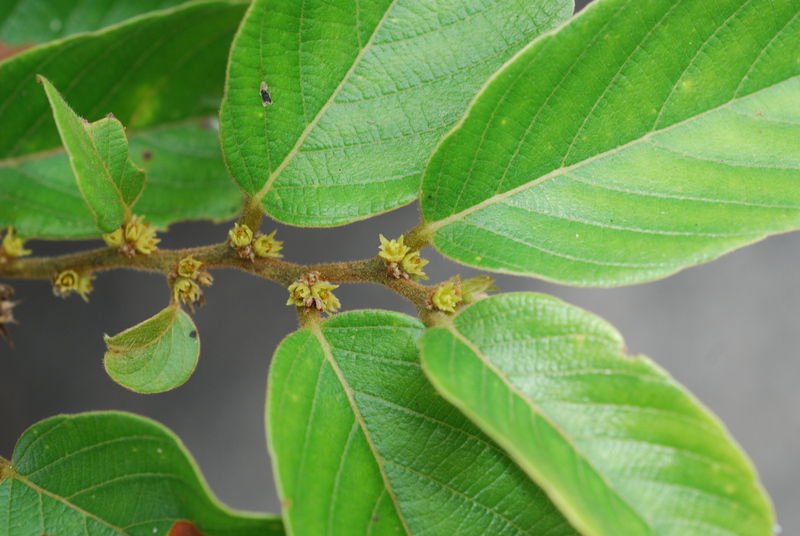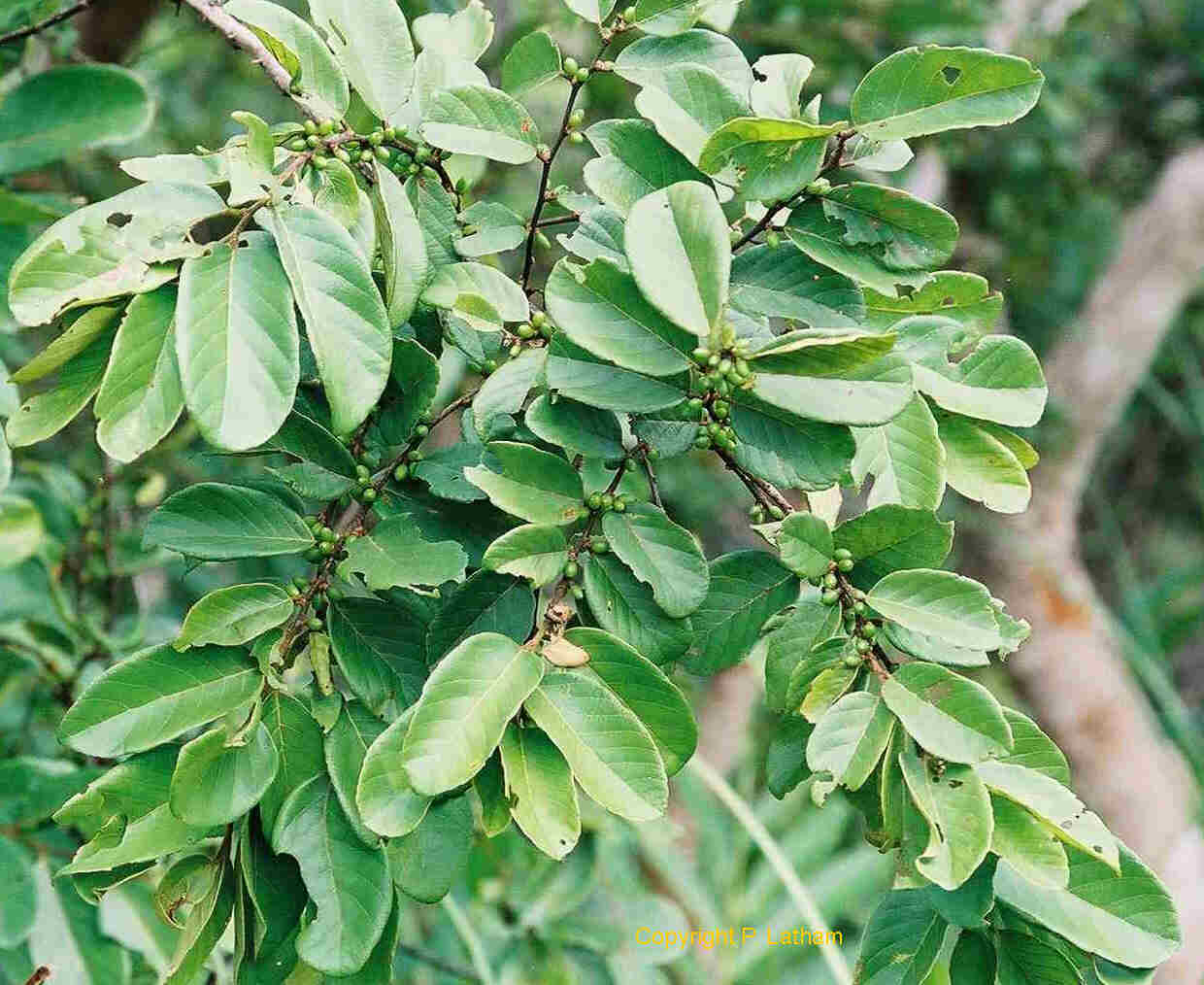Bridelia ferruginea Benth.
| Botanical Name | Bridelia ferruginea Benth. |
| Order: | Malpighiales |
| Family: | Phyllanthaceae |
| Genus: | Bridelia |
| Species: | Bridelia ferruginea |
| Common Names: | English: Bridelia |
Plant Synonyms
Bridelia ferruginea var. gambicola Hiern
Plant Local Names
Benin: Baatonun- bemebenku, Gbe Fo- honsukokue, Yoruba – nago hira
Burkina Faso: Moore –ambriaka, Dioula- sagou; sagwann baboni, Fulfulde- kojutekj; daafi
Cote d’Ivoire: Manding maninka- baboni, Maninka- saba/sagba, Senufo- dyimini – nakurugo
Ghana: Tw – opam fufuo, Ga adamgbe – flatsho,
Guinea: Fula pulaar – dafi, Manding maninka- baboni, Maninka – sagba
Mali: Bambara – saguan, Noms – daafi, Senoufo – guirin-o-tique
Nigeria: Yoruba – ilra odan; eepo ira, Ibo – oha, Hausa – kisni
Sierra Leone: Susu – tholinyi, Kissi – sindio, Hono – bembeh
Togo: Ewe – akamati, Bassar – n’tchinchtchi, Lamba – kolu
Plant Habitat
Occurs commonly in the Guinea savannah and coastal plains Africa, particularly Burkina Faso, Cote d’Ivoire, Ghana, Nigeria, and Togo as well as Asia and Australia
Plant Material of Interest
Leaf, root and stem – bark
Plant Description
It is a small non-laticiferous, scaly tree or shrub that grows to about 4 - 15 m tall and up to 1.5 m in girth, branching is low, often bears spines and may be slash crimson coloured; leaves may be small to medium-sized, simple, petiolate with stipules, oval- lanceolate, tomentose, deciduous, alternate, spiral, lamina broadly elliptic, with entire margin and an acuminate or acute apex (GHP, 1992); cuticles oblong or oval, irregularly more or less dentate, upper epidemis pubescent; about 3.8-10.0 cm long and 2.5-6.4 cm wide with slightly wavy edges; shortly and abruptly acuminate, stalk pinnately veined, veins beneath form a dense and prominent network, sometimes sparsely hairy and occasionally with the hairs obscuring the undersurface of the leaf; inflorescence, many flowered in glomerules, axillary, very dense, male yellowish-green, pedicelate, pedicel, 1.5 - 2 mm long; female flowers subsessile with 3 short, 2-pronged styles, 0.6 cm across, the greenish yellow sepals have very small and narrow petals; each flowers cluster usually consist of male and female; good fragrance fruits drupe-shaped, unilocular, oblong or sometimes subglobulose with green pericarp, red then black blue at maturity; fruits sometimes obovoid, 0.8 cm long, more usually ellipsoid, 0.6 cm long very persistent on the branches; stem –bark, dark grey cracked, rough, often markedly scaly, slash is thin and red, branches are long sometimes thorny, thin sometimes equipped with short, sharp spines; branches are rusty and pubescent; twigs are usually covered with short often rust-coloured hairs (Adjanahoun et al., 1991; Okunji, 1987).
Plant Used Parts
Plant Uses
Bacterial infections; diabetes, arthritis, bruises, boils, dislocation, burns, paediatric illnesses (especially malarial fever), dysentery, diabetes, thrush (mycoctic stomatitis) in children, antidote for snake bites; gonorrhoea; helminthiasis; malarial; trypanosomes; inflammations sexually transmitted diseases (Okpekon et al., 2004; Olajide et al., 2003 Irobi et al., 1994; Narayan, 1994; Iwu, 1993; Hemtchoya, 1991; Oliver Bever, 1960; Dalziel, 1937).
Plant Therapeutic Action
Antidiabetic, antihypertensive; antiviral and –HIV, antibacterial, antifungal, anti-inflammatory, antispasmodic; antipyretic; and analgesic, anthelmintic; anti-tumour, duretic.
Plant Precaution for Use
Caution should not be taken in the administration of the aqueous extract in patients with compromised liver and renal function.
Plant Adverse Effect
Excessive dose may lead to hypoglycaemia
Plant Contraindication
Known renal and/ or hepatic patients, hypoglycaemia, elderly and children.
Plant Dosage Forms
Infusion: 20 g of dried leaf per litre of water, brew for 15 minutes and take 3-4 cups a day;
Decoction boil 0 g of dried leaf in one litre of water fo 15 minutes; drink 3-5 cups a day;
Tincture: 1:5 in 30% alcohol; 5 ml three times daily.
Plant Dosage
Decoction; infusion and tincture
Plant Storage
Store in a cool, dry place.
Plant Chromatographic Fingerprint
Analytical TLC on sillca gel G60 F 254, 0.25 mm layer in petroleum ether (40-60? Cychloroform (2:B). detection in daylight, after spraying with anisadehyde(o.5 ml) mixed with 10 ml glacial acetic acid 85 ml methanol and 5 ml concentrated sulphuric acid and heated to 100- 110? For 5-10 min. Presence of four characteristicsspots with R,s values of 0.92 (violet), 0.81 (pink), 0.65 (pink) and 0.37 (purple).
Plant Constituents
flavonoids (bridelliactone and brideliactoside, apigenin and kaempterol, gallocatchin –(4-0-7-epigallocateechin, qwercetin- 3, 3- methylether, 3,5- dicaffeolqinic acid, quercetin 3-0- glucoside, rutin, myricitrin, myricetin- 3- 0 – 3(gallocatechin- (4-0-7)- apigallocatechin); triterpenoids, lgnans; phenols and tannins (Cimenga et al., 2001, Rashid et al., 2000; Addae-Mensah and Achenbach, 1985; Irobi et al., 1994; GHP, 1992; de-Bruyne et al., 1998; Oliver- Bever, 1960).
Plant References
Addae-Mensah, I., Munenge, R.W. (1989). Quercetin-3-nechesperidose (rutin) and other flavonoids as the active hypoglycaemic agents in Bridelia ferruginea. Fitoterapia Lx (4): 350-362.
Addae-Mensah, I., (1992). Towards a Rational Scientific Basis for Herbal Medicine: A Phytochemist Two-decade Contribution. Accra: Ghana Univesities Press. 22-27.
Addae-Mensah, I., Achenbach, H. (1985). Tepenoids and flavonoids of Bridelia ferruginea. Phytochemistry 24(8):1817-1819.
Adjanohoun, E et al., (1991) Contribution to ethnobotanical and floristic studies in Western Nigeria. Published by the Scientific Technical and Research Commission of the Organization of African Unity, Lagos Nigeria.
Akinpelu, D.A., Olorunmola F.O. (2000). Antimicrobial Activity of Bridelia ferruginea fruit. Fitoterapia 71:75-76.ampofo, O. (1977). Some clinical observation on the treatment of selected diseases by herbal preparations. Paper presented at the International Conference on Medicinal Plant Research University of Ife, Nigeria.
Ayensu, E.s. (1978). Medicinal Plants of West Africa Michigran: Refernce Publication Inc., p. 121-122.
Cimanga, K., Ying L., de Bruyne T., Apers S., Cos P., et al., (2001). Radical scavenging and xanthine oxidase inhibitory activity of phenolic compounds from Bridelia ferruginea stem bark. Journal of Pharmacy and Pharmacology 53:5:757-761.
Cimanga, K., Ying L., de Bruyne T., Apers S., Pieters, L. et al. (1999). Complement – inhbiting Constituents of Bridelia ferruginea stem Bark. Planta Medica 65:213-217.


